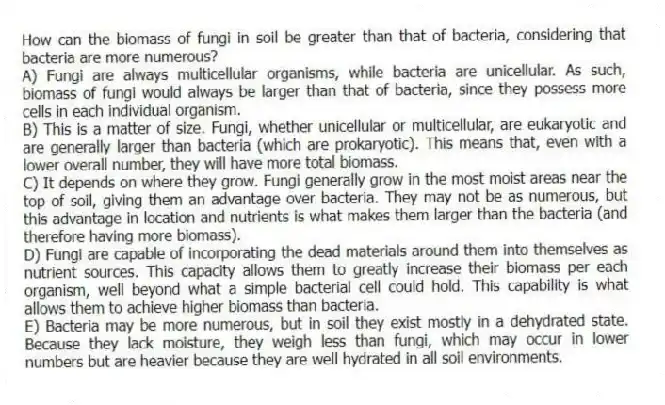
How can the biomass of fungi in soil be greater than that of bacteria, considering that bacteria are more numerous?
A) Fungi are always multicellular organisms, while bacteria are unicellular. As such, biomass of fungi would always be larger than that of bacteria, since they possess more cells in each individual organism.
B) This is a matter of size. Fungi, whether unicellular or multicellular, are eukaryotic and are generally larger than bacteria (which are prokaryotic) . This means that, even with a lower overall number, they will have more total biomass.
C) It depends on where they grow. Fungi generally grow in the most moist areas near the top of soil, giving them an advantage over bacteria. They may not be as numerous, but this advantage in location and nutrients is what makes them larger than the bacteria (and therefore having more biomass) .
D) Fungi are capable of incorporating the dead materials around them into themselves as nutrient sources. This capacity allows them to greatly increase their biomass per each organism, well beyond what a simple bacterial cell could hold. This capability is what allows them to achieve higher biomass than bacteria.
E) Bacteria may be more numerous, but in soil they exist mostly in a dehydrated state. Because they lack moisture, they weigh less than fungi, which may occur in lower numbers but are heavier because they are well hydrated in all soil environments.
Correct Answer:
Verified
Q50: Mycorrhizae are a symbiotic association of
A) bacteria
Q51: No eukaryotic organisms have been shown to
Q52: Which statement describes the relationship between ammonia
Q53: Which of the following involve symbiotic relationships?
A)
Q54: Streptomyces produces geosmins which give soil a
Q56: Many orchids require fungi for seeds to
Q57: Sulfur occurs in all living matter primarily
Q58: Oligotrophic waters are usually hypoxic.
Q59: Truffles
A) are endomycorrhizas.
B) are a mushroom.
C) are
Q60: The rumen is
A) found in horses and
Unlock this Answer For Free Now!
View this answer and more for free by performing one of the following actions

Scan the QR code to install the App and get 2 free unlocks

Unlock quizzes for free by uploading documents